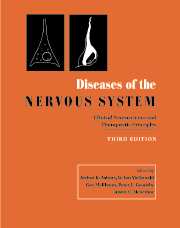Book contents
- Frontmatter
- Dedication
- Contents
- List of contributors
- Editor's preface
- PART I INTRODUCTION AND GENERAL PRINCIPLES
- PART II DISORDERS OF HIGHER FUNCTION
- PART III DISORDERS OF MOTOR CONTROL
- PART IV DISORDERS OF THE SPECIAL SENSES
- PART V DISORDERS OF SPINE AND SPINAL CORD
- PART VI DISORDERS OF BODY FUNCTION
- PART VII HEADACHE AND PAIN
- PART VIII NEUROMUSCULAR DISORDERS
- PART IX EPILEPSY
- PART X CEREBROVASCULAR DISORDERS
- PART XI NEOPLASTIC DISORDERS
- PART XII AUTOIMMUNE DISORDERS
- PART XIII DISORDERS OF MYELIN
- PART XIV INFECTIONS
- 101 Host responses in central nervous system infection
- 102 Viral diseases of the nervous system
- 103 Neurological manifestations of HIV infection
- 104 Neurological manifestations of HTLV-I infection
- 105 Clinical features of human prion diseases
- 106 Bacterial infections
- 107 Parasitic disease
- 108 Lyme disease
- 109 Neurosyphilis
- 110 Tuberculosis
- PART XV TRAUMA AND TOXIC DISORDERS
- PART XVI DEGENERATIVE DISORDERS
- PART XVII NEUROLOGICAL MANIFESTATIONS OF SYSTEMIC CONDITIONS
- Complete two-volume index
- Plate Section
108 - Lyme disease
from PART XIV - INFECTIONS
Published online by Cambridge University Press: 05 August 2016
- Frontmatter
- Dedication
- Contents
- List of contributors
- Editor's preface
- PART I INTRODUCTION AND GENERAL PRINCIPLES
- PART II DISORDERS OF HIGHER FUNCTION
- PART III DISORDERS OF MOTOR CONTROL
- PART IV DISORDERS OF THE SPECIAL SENSES
- PART V DISORDERS OF SPINE AND SPINAL CORD
- PART VI DISORDERS OF BODY FUNCTION
- PART VII HEADACHE AND PAIN
- PART VIII NEUROMUSCULAR DISORDERS
- PART IX EPILEPSY
- PART X CEREBROVASCULAR DISORDERS
- PART XI NEOPLASTIC DISORDERS
- PART XII AUTOIMMUNE DISORDERS
- PART XIII DISORDERS OF MYELIN
- PART XIV INFECTIONS
- 101 Host responses in central nervous system infection
- 102 Viral diseases of the nervous system
- 103 Neurological manifestations of HIV infection
- 104 Neurological manifestations of HTLV-I infection
- 105 Clinical features of human prion diseases
- 106 Bacterial infections
- 107 Parasitic disease
- 108 Lyme disease
- 109 Neurosyphilis
- 110 Tuberculosis
- PART XV TRAUMA AND TOXIC DISORDERS
- PART XVI DEGENERATIVE DISORDERS
- PART XVII NEUROLOGICAL MANIFESTATIONS OF SYSTEMIC CONDITIONS
- Complete two-volume index
- Plate Section
Summary
In the mid-1970s several dozen patients living near Lyme Connecticut developed an illness, initially misdiagnosed as juvenile rheumatoid arthritis, and subsequently called Lyme arthritis (Steere et al., 1977). It was renamed Lyme disease when its systemic nature was appreciated. In retrospect, skin and neurological manifestations of Lyme disease had been described in Europe for decades, and had even been recognized as antibiotic responsive (Coyle, 2000). Lyme disease is a multisystem infection due to the spirochete Borrelia burgdorferi. This spirochete, named after its discoverer Willy Burgdorfer, is present in hard body ticks of the Ixodes ricinus family (Burgdorfer, 1984). Ixodes ticks feed on a variety of hosts, including humans. Virtually all transmissions occur through tick bite, although there have been rare congenital cases. To date, there have been no documented blood transfusion cases (McQuiston et al., 2000). Lyme disease is one of the major emerging pathogen infections. It has generated significant publicity and controversy, and has become a focus of interest for both lay action groups and the popular press.
Spirochetal infection
B. burgdorferi is a spirochete. Spirochetes are gram negative bacteria that belong to a distinct eubacterial phylum (Benach & Coleman, 1993; Reik, 1987). They are flexible cells with a helical configuration, excessive length to diameter ratios of up to 100 to one, and flagella that lie between inner and outer cell membranes. These endoflagella convey motility properties. Of the four recognized human spirochetal infections which cause neurological disease, all show frequent central nervous system (CNS) seeding during the spirochetemic stage (Table 108.1). CNS infection may be inapparent, or associated with clinical disease. Spirochetes can also persist silently within the CNS, only to cause late neurologic problems months to years after initial infection. These spirochetal disorders have a number of features in common (Table 108.2). The shared features provide guidelines to think about Lyme disease
Organism
Borrelia spirochetes have coils which are spaced irregularly 2 to 4 micrometres (μm) apart (Benach&Coleman, 1993). B. burgdorferi is easy to culture from ticks, but difficult to culture frompatients.The spirochete is 11 to 39mcmlong.
- Type
- Chapter
- Information
- Diseases of the Nervous SystemClinical Neuroscience and Therapeutic Principles, pp. 1754 - 1765Publisher: Cambridge University PressPrint publication year: 2002

